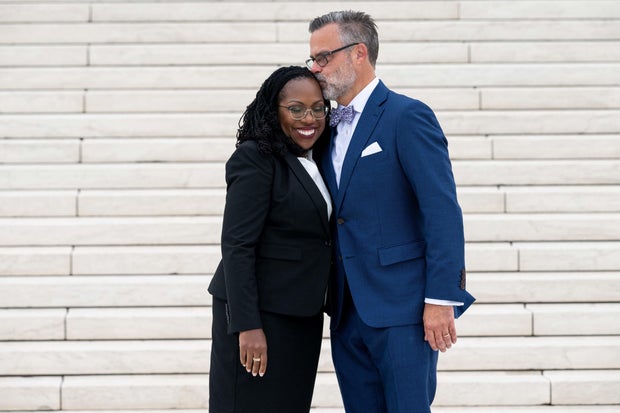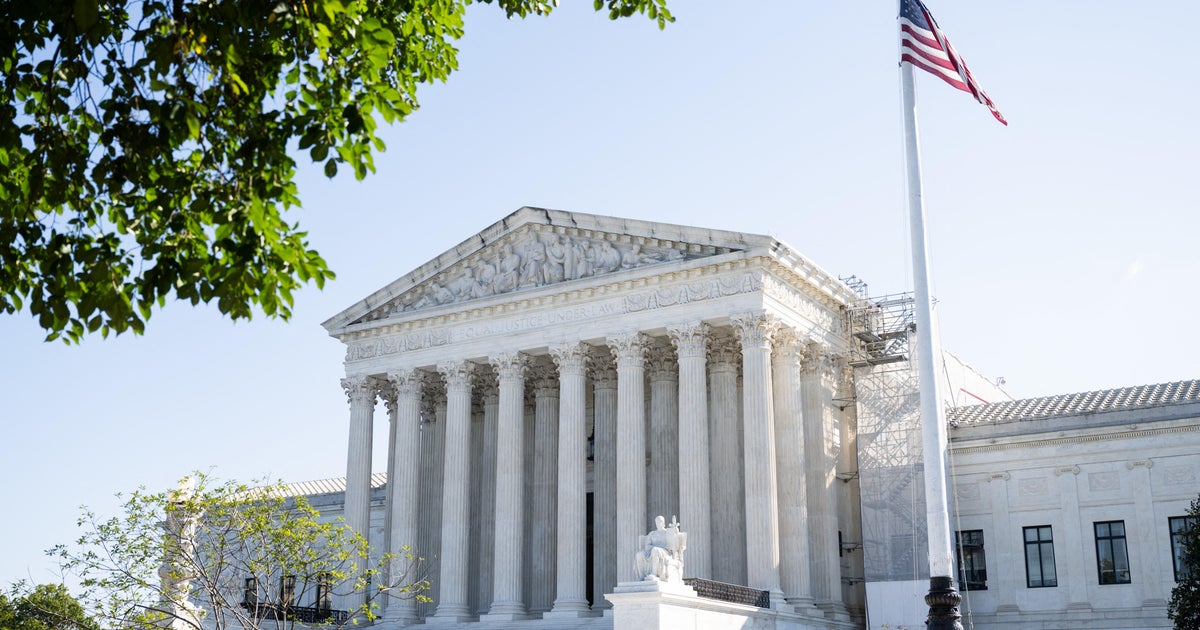CBS News
At Harvard, Ketanji Brown Jackson knew about a White student fighting to remove a Confederate flag. He is now her husband.

Ketanji Brown Jackson is the first Black woman to serve as a Supreme Court justice, but decades before, she was a Harvard student trying to find her way. That’s when she met Patrick Jackson, a White classmate who joined an effort to have a Confederate flag removed from campus. He went on to become her husband.
In an interview with Gayle King for CBS Mornings to talk about her new book “Lovely One,” the justice opened up about how she and Jackson met and navigated their interracial relationship.
“I love the backstory of your meeting. I already see the movie,” King said.
Brown Jackson said she and her now-husband were in a class together called “Changing the Concept of Race in America,” and started out as friends. But over time, she began to like him as something more.
However, Brown Jackson was worried about meeting his family. He grew up White and privileged and his grandmother had offered to pay for his medical schooling. She worried that after finding out he had a Black girlfriend, that generous offer would be taken off the table.
“I mean I was just nervous about the whole scenario. My parents had grown up in the South and segregation and, you know, this was an interracial relationship, which was unusual,” she said.
Jackson reassured her it would work out.
“At one point he said, ‘I choose you,’ because I was worried that, you know, his grandmother had promised to pay for his medical school, and I was worried that it might mean that when she found out about me, she wouldn’t do it,” Brown Jackson said. “And he said, ‘Even if I have to take a job or do something else, I choose you.'”
Brown Jackson called that “pretty extraordinary.”
SAUL LOEB/AFP via Getty Images
She also said her parents came around to support their relationship. But, as King pointed out, her father told her, “We trust Patrick, but this is America.”
While Brown Jackson said it was scary at first to be in an interracial relationship, her parents realized she and her husband were right for each other and shared a lot of the same values.
The pair went on to marry in 1996 and have two daughters.
“Patrick believed and Patrick knew that this was going to happen for you,” King said. “Talk about somebody who believed in you from the very beginning.”
Jackson, in the studio for the CBS Mornings interview, wiped away tears watching his wife.
Brown Jackson shared another story from Harvard that stuck with her all these years. It was a short, one-word interaction with a stranger who passed her while walking down a path.
“Well, I was feeling really depressed at the time, you know, so many freshmen go through the, you know, imposter syndrome,” she said, adding that she was not sure if she belonged at Harvard.
“And this woman passed me on the path and leaned over and she said, ‘Persevere.’ And then she kept going,” she said. “I was like, wow. You know. It just really stuck with me. And started to change my view of what I was doing there.”
After graduating from Harvard-Radcliffe in 1992 with a Bachelor’s Degree in government, she went on to Harvard Law School, graduating in 1996. After working in private practice and three federal clerkships she served on the U.S. District Court for the District of Columbia from 2013 to 2021, until President Biden appointed her to the Supreme Court.
Jabin Botsford/The Washington Post via Getty Images
During her confirmation hearing, a photo of her husband and daughter Leila went viral. The teen stared proudly at her mom, who was about to become the first Black woman to serve on the nation’s highest court.
King said the shot made her tear up.
“It was such a moment of pride. You didn’t see it in that moment. But when you saw it, what did you think? It seemed to say so many things to me,” King said.
“It did,” Brown Jackson said. “So many people came up to me and talked about how that picture had moved them.” She said realizing how proud her daughter was was a “wonderful thing.”
CBS News
Here Comes the Sun: Jack Antonoff and more

Watch CBS News
Be the first to know
Get browser notifications for breaking news, live events, and exclusive reporting.
CBS News
Capturing Moriah Wilson’s Killer – CBS News

Watch CBS News
Be the first to know
Get browser notifications for breaking news, live events, and exclusive reporting.
CBS News
How to watch the Minnesota Vikings vs. Chicago Bears NFL game today: Livestream options, more

Getty Images
The Minnesota Vikings will take on the Chicago Bears today. The Vikings are currently 8-2, an impressive run so far this season, and will be looking to add a fourth win to their current streak after last Sunday’s 23-13 win against the Tennessee Titans. The Bears, on the other hand, are entering this game on the heels of a four-game losing streak after a tough 20-19 loss against the Green Bay Packers last Sunday.
Here’s how and when you can watch the Vikings vs. Bears game today, whether or not you have cable.
How and when to watch the Minnesota Vikings vs. Chicago Bears
The Vikings vs. Bears game will be played on Sunday, November 24, 2024 at 1:00 p.m. ET (11:00 a.m. PT). The game will air on Fox and stream on Fubo and the platforms featured below.
How and when to watch the Minnesota Vikings vs. Chicago Bears game without cable
You can watch this week’s NFL game on Fox via several streaming services. All you need is an internet connection and one of the top options outlined below.
Fubo offers you an easy, user-friendly way to watch NFL games on CBS, Fox, NBC, ABC, ESPN, and NFL Network, plus NCAA football channels. The Pro tier includes 200+ channels and unlimited DVR, while the Elite with Sports Plus tier adds NFL RedZone and 4K resolution. New subscribers get a seven-day free trial and all plans allow streaming on up to 10 screens simultaneously.
You can watch today’s game with a subscription to Sling’s Orange + Blue tier, which includes ESPN, ABC, NBC, and Fox. The plan offers 46 channels with local NFL games, nationally broadcast games and 50 hours of DVR storage. For complete NFL coverage, add Paramount+ to get CBS games, or upgrade with the Sports Extra add-on for additional sports channels like Golf Channel, NBA TV and NFL RedZone.
Watching NFL games, including Fox broadcasts, is simple with Hulu + Live TV, which includes 90 channels, unlimited DVR storage, and access to NFL preseason games, live regular season games and studio shows. The service includes ESPN+ and Disney+ in the subscription.
Want to watch today’s game live on your smartphone? If so, NFL+ streaming service is the solution you’re looking for. It lets you watch NFL Network and out-of-market games on mobile devices, with an upgrade option to NFL+ Premium that includes NFL RedZone for watching up to eight games simultaneously. Note that NFL+ only works on phones and tablets, not TVs.










